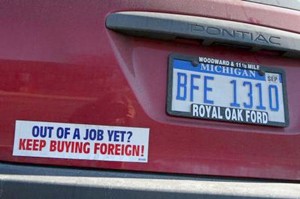
Buying American is a emotionally charged issue in a state that is very dependent on the auto industry.
Call it the automotive equivalent of playing the race card.
Talk to potential car buyers – especially in a crowd such in the lunchroom at the office – and the subject of buying American often comes up. It can be a touchy subject, especially in Michigan, where the state’s battered economy depends so heavily on the domestic auto industry.
Just in case you don’t think this is a contentious issue, talk to the guy with the bumper sticker that says “Out of a job yet? Keep buying foreign!”
But with the globalization of the economy so prevalent, it’s hard to tell an American car from a foreign one anymore. Some would say that you simply look at the grille. If there’s a logo from a brand owned by GM, Ford or Chrysler then it’s American. But it’s really not that simple.
Consider this example. Mary buys a Honda Accord, built in Ohio with more than 90 percent U.S. and Canadian parts content. Bob buys a Dodge Challenger, which has North American parts content of less than 70 percent. Who bought the American car?
Or, John, who bought a Chevrolet Aveo, which was designed and is built in Korea (although, production moves to Michigan beginning next year). Is he more patriotic than Joan, who owns a Toyota Camry that was built in Kentucky?
Ford’s vaunted new Fiesta was largely designed in Europe and is built in Mexico for the U.S. market. The Chevrolet Camaro is based on an Australian platform – that’s right the all-American sports car speaks Aussie – and is built in Canada. A legitimate question is whether the Camaro is more American than a Toyota Venza, the first Toyota designed and engineered in Ann Arbor at the company’s new research and development center.
In the end, the domestic automakers have finally realized they will have to build great cars to win over buyers. Being the home team isn’t enough. Cars are such an expensive investment, most people can’t afford to buy an inferior one just so they can say they bought a car from a particular country.
The domestics have improved – dramatically. Ford has crowed loudly of late that quality surveys place it on par or above Toyota. On top of that, Ford is filling its vehicles with the latest infotainment and powertrain technology, even outpacing Honda.
After years building lackluster and sometimes weird vehicles, GM is finally turning out one really good product after another. It’s revolutionary Chevrolet Volt has the potential to force a quantum shift in the industry.
Chrysler is a bit behind the other two domestics, but the new Jeep Grand Cherokee shows that the potential is there to make great cars.
New labor deals with the UAW have been painful for workers and retirees, but they are helping to level the playing field, allowing the domestics to compete straight up with the foreign automakers.
